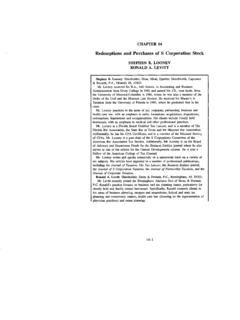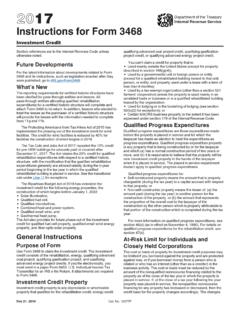Transcription of Asset Acquisitions: Assuming and Avoiding Liabilities
1 913 Asset Acquisitions: Assuming and Avoiding Liabilities Byron F. Egan* Table of Contents I. INTRODUCTION .. 914 II. WHETHER TO DO AN Asset PURCHASE .. 917 A. Purchased Assets .. 917 B. Contractual 918 C. Intellectual Property 919 D. Governmental Authorizations .. 920 E. Assumed 920 F. Dissent and Appraisal Rights .. 923 1. Delaware Law .. 924 2. Texas Law .. 925 G. Income Taxes .. 926 H. Transfer Taxes .. 929 I. Employment Issues .. 930 J. Confidentiality Agreement .. 930 K. Exclusivity Agreement .. 930 L. Letter of Intent .. 931 III. SUCCESSOR LIABILITY .. 931 A. Background .. 931 B. The General Rule of Successor Liability.
2 933 1. Express or Implied Assumption .. 935 2. De Facto Merger .. 935 * Byron F. Egan is a partner of Jackson Walker in Dallas, Texas. Mr. Egan is a member of the ABA Business Law Section s Mergers & Acquisitions Committee, serves as Senior Vice Chair of the Committee and Chair of its Executive Council and served as Co-Chair of its Asset acquisition Agreement Task Force which prepared the ABA Model Asset Purchase Agreement with Commentary. Mr. Egan wishes to acknowledge contributions of the following in preparing this paper: Richard De Rose of Houlihan Lokey Howard & Zukin in New York, NY; Robert T.
3 Harper of Buchanan Ingersoll & Rooney PC in Pittsburgh, PA; Frances Murphy of Slaughter and May in London, UK; Michael L. Schler of Cravath, Swaine & Moore LLP in New York, NY; H. Lawrence Tafe III of Day Pitney LLP in Boston, MA; Prof. Samuel C. Thompson, Jr. of The Dickinson School of Law of the Pennsylvania State University in University Park, PA; Donald J. Wolfe Jr. of Potter Anderson & Corroon LLP in Wilmington, DE; and Kristina M. Campbell, Michael L. Laussade, Robert P. Hyndman, and Peter K. Wahl of Jackson Walker in Dallas, TX. 914 PENN STATE LAW REVIEW [Vol. 116:3 3. Mere Continuation.]
4 939 4. Fraud .. 939 5. Continuity of Enterprise .. 940 6. Product-Line Exception .. 940 7. Duty to Warn .. 943 8. Inadequate Consideration/Creditors Not Provided For .. 943 9. Liability Imposed By Statute or Superseding Law .. 944 a. Environmental Statutes .. 945 b. Federal Common Law/ERISA .. 947 c. Effect of Bankruptcy Court Orders .. 948 C. Some Suggested Responses .. 950 1. Analysis of Transaction .. 950 a. Product Liability .. 950 b. Environmental Cases .. 951 c. Applicable Laws .. 953 2. Structure of Transaction .. 953 3. Asset Purchase Agreement Provisions .. 954 a. Liabilities Excluded .. 954 b. Indemnification.
5 954 4. Selling Corporation Survival .. 954 5. Limitation on Assets .. 955 I. INTRODUCTION Buying or selling a closely held business, including the purchase of a division or a subsidiary, can be structured as (i) a statutory combination such as a statutory merger or share exchange, (ii) a negotiated purchase of outstanding stock from existing shareholders, or (iii) a purchase of assets from the business. The transaction typically revolves around an agreement between the buyer and the selling entity, and sometimes its owners, setting forth the terms of the deal. Purchases of assets are characterized by the acquisition by the buyer of specified assets from an entity, which may or may not represent all or substantially all of its assets, and the assumption by the buyer of specified Liabilities of the seller, which typically do not represent all of the Liabilities of the seller.
6 When the parties choose to structure an acquisition as an Asset purchase, there are unique drafting and negotiating issues regarding the specification of which assets and Liabilities are transferred to the buyer, as well as the representations, closing conditions, indemnification, and other provisions essential to memorializing the bargain reached by the parties. There are also statutory ( , bulk sales and fraudulent transfer statutes) and common law issues ( , de facto merger and other successor liability theories) unique to Asset purchase transactions that could result in an Asset 2012] Asset ACQUISITIONS 915 purchaser being held liable for Liabilities of the seller which it did not agree to assume.
7 These drafting and legal issues are dealt with from a United States ( ) law perspective in (1) the Model Asset Purchase Agreement with Commentary, which was published by the Mergers & Acquisitions Committee (formerly named the Negotiated Acquisitions Committee) (M&A Committee) of the American Bar Association (ABA) in 2001 (Model Asset Purchase Agreement, or Model Agreement); (2) the Revised Model Stock Purchase Agreement with Commentary, which was published by the M&A Committee in 2010 (Model Stock Purchase Agreement, or RMSPA); and (3) the Model Merger Agreement for the acquisition of a Public Company, which was published by the M&A Committee in 2011 (Model Public Company Merger Agreement).
8 In recognition of how mergers and acquisitions (M&A) have become increasingly global, the Model Asset Purchase Agreement was accompanied by a separate M&A Committee volume in 2001 entitled International Asset Acquisitions, which included summaries of the laws of 33 other countries relevant to Asset acquisitions, and in 2007 was followed by another M&A Committee book, which was entitled International Mergers and Acquisitions Due Diligence and surveyed relevant laws from 39 countries. A number of things can happen during the period between the signing of a purchase agreement and the closing of the transaction that can cause a buyer to have second thoughts about the transaction.
9 For example, the buyer might discover material misstatements or omissions in the seller s representations and warranties, or events might occur, such as the filing of litigation or an assessment of taxes, that could result in a material liability or, at the very least, additional costs that had not been anticipated. There may also be developments that could seriously affect the future prospects of the business to be purchased, such as a significant downturn in its revenues or earnings or the adoption of governmental regulations that could adversely impact the entire industry in which the target operates.
10 The buyer initially will need to assess the potential impact of any such misstatement, omission, or event. If a potential problem can be quantified, the analysis will be somewhat easier. However, the impact in many situations will not be susceptible to quantification, making it difficult to determine materiality and to assess the extent of the buyer s exposure. Whatever the source of the matter, the buyer may want to terminate the acquisition agreement or, alternatively, to close the transaction and seek recovery from the seller. If the buyer wants to terminate the agreement, how strong is its legal position and how great is the risk that the seller will dispute termination and commence a 916 PENN STATE LAW REVIEW [Vol.]










